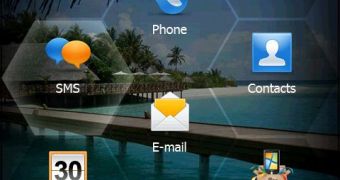Windows Mobile 6.5 supports primary main gestures that together will represent the backbone of the interaction model introduced by the operating system. And make no mistake about it, although Windows Mobile and Windows CE are in no way strangers to touch screen interfaces, the fact of the matter is that gesture support is something entirely new for the Windows operating system designed for mobile phones. However, the introduction of gesture support falls within the Redmond company's general strategy to adopt natural user interfaces across its platforms.
“Touch gestures describe gestures in which you use a finger or stylus to make a short, directional movement over a control or object on the screen. Most gestures are a single stroke. Therefore, they correspond to one finger–down (WM_LBUTTONDOWN) and finger–up (WM_LBUTTONUP) event pair. The exception is double tap, in which there are two finger–down and finger–up event pairs in short succession. Gestures are recognized based on finger–down and finger–up events, plus the direction, position, and velocity calculated by the gesture recognizer,” Microsoft explained .
Select or Tap, Double Tap or Double Select, Hold, Flick or Scroll and Pan are the five kinds of gestures supported by Windows Mobile. Developers looking to take advantage of the Windows Mobile 6.5 NUI should know that Microsoft has published the official documentation associated with using gestures with the operating system. One portion of the resources available is designed to describe the touch gestures. Here is their description according to Microsoft:
Tap - A tap represents the left click of a mouse. The application receives a single GID_SELECT gesture message when the finger–down and finger–up events occur in a defined time period and a specific distance from each other. There can be several WM_MOUSEMOVE messages after the WM_LBUTTONDOWN event and before the GID_SELECT message.
Double Tap - A double tap represents the left double click of a mouse. The application receives a GID_DOUBLESELECT gesture message when the finger–up events occur in a defined time period and within a specific distance of each other.
Hold - The user can press and hold on the screen to represent the right click of a mouse. The application receives a single GID_HOLD message when the finger remains down for longer than a defined time period and all points during that period are within a specific distance. It is followed by a GID_END message on finger–up or at the end of the Hold time threshold.
Flick - The user can move a finger across the screen to initiate per-pixel scrolling, and if this movement is fast enough, scrolling will continue after the finger is lifted. The application receives a single GID_SCROLL gesture message at the end of the movement upon finger-up. A flick frequently occurs after a pan (one or more GID_PAN gesture messages, followed by a GID_SCROLL message, and then a GID_END message).
Pan - The user can press and hold on the screen and then drag the finger in any direction to represent a mouse move event. The application receives one or more GID_PAN gesture messages as the position changes followed by a GID_END when the finger is lifted. Mouse messages are interleaved with gesture messages. Panning can occur after a Hold gesture.

 14 DAY TRIAL //
14 DAY TRIAL //